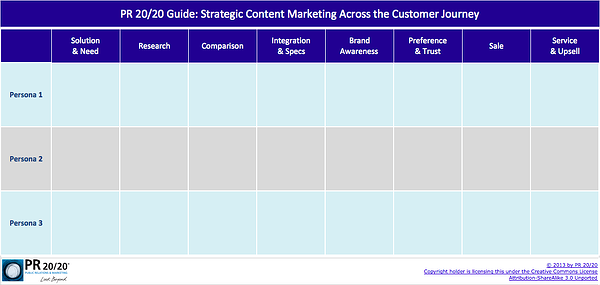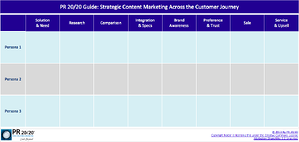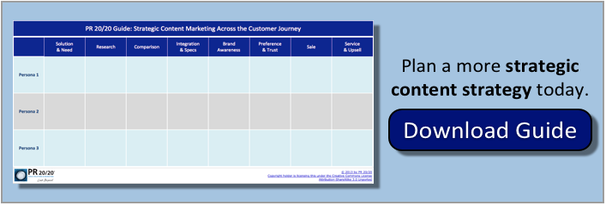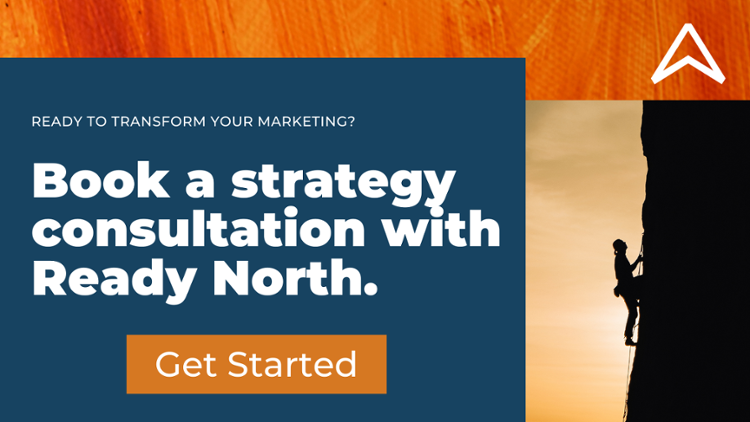There’s trouble in paradise: content marketers and their audiences have a communication breakdown.
According to the 2013 B2B Content Marketing Benchmarks, Budgets and Trends research report, 64% of marketers indicate that producing enough content is their biggest challenge. In terms of upcoming content strategy, the 2014 trends report indicates that 73% of B2B marketers plan to produce more content now compared to one year ago, and 58% will increase content marketing budget from last year.
But in the midst of a marketing craze that’s all about quantity, consumers (and search engines) have risen above to demand quality, helpful and entertaining content. Clearly, what should be a match made in heaven is suffering from misaligned expectations. If we’re going to make this relationship last, it’s time to care about quality.
As marketers, let’s turn focus away from who has the most blog posts to who has the best blog posts. Focus on producing high-quality content, and content that resonates when it matters most—across the customer journey.
How? It starts by getting organized.
Where Does Content Connect with Your Audiences?
Every strategic content strategy should map content to specific personas across the sales cycle. A la something that resembles the following:

You can download an interactive Excel version of the guide at the end of this post.
Apply the persona / sale cycle strategy to your own content marketing efforts. List personas along the first column. These can be as broad or detailed as you’d like, depending on your brand’s specific buyer. List your buyer’s typical milestones throughout the customer journey across your top row. In the example above we list typical stages of a sales cycle, but yours can be even more targeted the more specific it becomes.
Tip: Discover your ideal customer’s typical journey to purchase by sitting down with your sales team. The conversation is invaluable—for your own marketing efforts, as well as longer-term goodwill, executive buy-in, and better aligned marketing and sales efforts.
Industry research and discussions with your sales team can fuel content for common stages and FAQs along the buying cycle. As Ardath Albee (@ardath421) explains in Less Is the New More, “If you truly know what questions your prospects need answered to take the next steps in their buying process, your efforts can be minimized by creating the content that delivers the right information at the right time.”
For example, thought leadership pieces on industry trends are often successful for creating awareness and bringing users into the sales funnel, while case studies or solution-specific content are better for leads toward the middle/bottom of the funnel. With the right content, you can guide prospects from initial touchpoint to close by giving them the exact information they need at each stage of the process.
Map Existing Assets to the Content Guide
Once you’ve nailed down personas, the typical stages of the customer journey, and specific challenges that arise along each persona’s path to purchase, you’re ready to take stock of existing content and map the matrix.
Need help prioritizing your most valuable content marketing assets? Look back at the content you’ve created over the last year, or over the last few years, and consider the following:
- Evaluate your top landing page and download analytics.
- Take stock of where content has been used across your site, emails, ads, etc.
- Grade your most popular guest posts.
- Look at earned media coverage and inbound links to your most popular posts.
- Examine your list of ideal or VIP customers, and look at their behavioral onsite content cues. Which posts, downloads or landing pages were most commonly viewed during the prospecting phase? Before purchase? As loyalty builds?
Take stock of your most valuable content assets, then map them accordingly for new leads. From here, it should be apparent where the holes in the matrix lie—and your content calendar will start populating with strategic, evergreen content drafted with a specific purpose in mind.
Fill Gaps Across the Funnel
Once you’ve mapped existing content, it’s easier to find gaps and prioritize content production.
In his post, Killer Content along the Buyer’s Journey: A Practical Guide to Monetize Your Content, Tom De Baere (@tomdebaere) writes about the role of content along the customer’s journey. Da Baere summarizes by placing content into three segments:
- Early-Funnel: Why do customers need a solution? Have they identified specific problems?
- Mid-Funnel: How does your solution solve said problems?
- Late-Funnel: What specifically does your brand offer? What differentiates it and builds trust?
Full Funnel Content Marketing
Throughout each stage of the customer journey, figure out which specific piece of content will cater best to your persona’s needs. In the visual above, we listed very generic stages of a sales cycle that’s common for a B2B client. The following offers guidance in filling the graph above with the right type of content.
-
Solution & Need
The earliest stage in the journey is where you can be really creative and helpful. Website visitors may be new and completely unaware of what your organization does—and that’s OK.
Write about the latest industry trends, discuss best practices and lessons learned, and identify real challenges the visitor is likely facing (without being over-salesy with your solution), etc. Early in the funnel is a good time to remind yourself that whether B2B or B2C, you’re communicating with other humans who have challenges and goals at work—and who appreciate a sense of humor.
-
Research
Visitors who have learned a little and like what they see will come back for additional information. Or, you can remind new leads that you have useful resources available via lead nurturing.
If prospects are interested enough in the challenge your brand helps solve, help them along the way with the research needed to make an informed purchase decision. It's what any friend or business partner would do.
Content in this stage ranges from your brand’s take on the latest analyst or leading vendor’s industry report (pull the highlights for your reader), to original, primary research or data, which can position your brand as a trusted industry thought leader.
-
Comparison
Once they’re a little more serious about a potential purchase, buyers want to know their options. They can find listings from an industry pub, buyers’ guide, consumer review blog, generic Google search—or you can provide comparison information for added helpfulness.
Make comparison guides easily available on your website, or send them along more exclusively via a lead nurturing campaign for more qualified prospects.
-
Integration & Specifications
At this stage in the funnel, your prospective customer wants to make a purchase happen. Here, it’s about the logistics of implementing your solution, so help prospects see your product or service fit seamlessly into their organization. The more details and assistance you can provide, the better.
While the specifics will vary based on your offering, consider standard integration and specification details such as installation requirements, interoperability with existing solutions, onboarding or training standards, maintenance needs, insurances and warranties, and more. This stage is a great place to feature case studies for target vertical market, so prospective customers can see their own company finding similar success.
-
Brand Awareness
Your prospective buyer is aware of other offerings on the market, and knows your solution will fit into the everyday of his or her business. Now it’s time to drive brand messaging home.
Why do you stand out against the competition, what’s your brand promise, and what drives your business? A deeper brand narrative is key when you’re setting the stage for the next step in your customer’s journey: preference and trust.
-
Preference & Trust
When all is said and done, people make purchases from other people, and often, your human resources and story is your most valuable asset.
Who are the people behind the brand, and what’s their story? Ideal content at this stage features company leadership, innovators, happy customers, the actual rep and service team who has been in contact (or will be in contact) with the individual prospect, and showcases the personal side of your business.
-
Sales
Formulate more natural, seamless sales with the right content support. Lead nurturing and the brand promise doesn’t end here—it takes off. Content at this milestone of the customer journey must be personalized, must validate a decision to purchase, and should continue to foster a real relationship with new customers.
Set your sales team up for success with complete transparency in communications leading up to this point. If your CRM is connected to your marketing automation system, ensure your team is familiar with past emails received, forms or questions submitted, downloads, etc. Then arm your sales team for continued marketing support beyond initial purchase.
-
Services & Upsell
Research from theWhite House Office of Consumer Affairs shows that on average, loyal customers are worth up to 10x their initial purchase.
Continually nurture existing customers. Content can come direct from their individual rep, or from c-level management to show business is valued.
Need content ideas for this last but not least stage of the customer journey? Consider specific product training or demos; roll out product before they officially go live for a feeling of exclusivity; send value-added perks or coupons; ask to feature customer success stories; and continue to send valuable market or primary research to maintain position as a thought leader and expert in your field.
Create the right pieces of content to strategically target your ideal buyer, and of course, test and evolve over time. As new content rolls out or becomes more popular with ideal customers, replace content in your matrix for newer prospects.
Related Resources
If you liked this post, you’d probably also enjoy Ready North colleague, Taylor Radey’s case for more strategic content—not necessarily more content—in the post, Work Smarter, Not Harder: Creating a Strategic Content Marketing Plan, which provides tips for a 12-month content marketing strategy.
For more information on how marketing and sales work together to drive business, check out these related Ready North posts:
- Marketing Strategy v. Sales Strategy
- Content Marketing and the Path to Purchase
- How Marketing Can Support the Sales Process
- Lead Logic: The Basics Behind A Lead Nurturing Strategy
How are you creating strategic content that connects with customers across the cycle? How are you proving its worth? Very interested to hear your thoughts in the comments below.

%20Logo_BlueOrange_Trademark.png?width=800&height=269&name=Ready%20North%20(RN)%20Logo_BlueOrange_Trademark.png)




.jpg?width=300&name=Services%20Hub%203%20(3).jpg)




COMMENTS